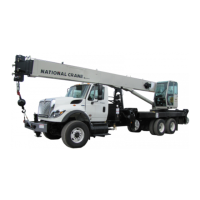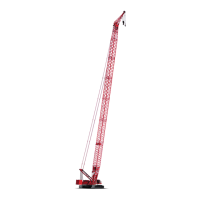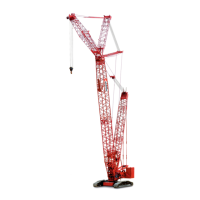Manitowoc Published 09-05-14, Control # 226-02 1-17
14000 SERVICE MANUAL INTRODUCTION
pressures can cause a slowing or stopping of operation. If
the charge pressure is set too high, the hydraulic system
could be damaged. When a system control handle is in
neutral the main display indicates system charge pressure.
If any charge pressure system drops, the system brake
begins to apply at approximately 200 psi (14 bar). Main
system pumps de-stroke as charge pressure drops to
minimum pressure.
Accessory System Pressure Sources
The low pressure side of drum 1 pump is the pressure
source for high pressure accessory system
components. The programmable controller controls
drum 1 pump output pressure when an accessory valve
is enabled.
Drum 3/left travel charge pump is the pressure source
for low pressure system components.
Hydraulic Motors
See hydraulic pump manufacturer’s manual for a description
of a hydraulic motor.
Variable displacement low torque/high speed, bent axis
piston hydraulic motors are used in the travel, boom hoist,
and load drum systems. The swing system motor is a fixed
displacement, low torque/high speed, fixed speed piston
hydraulic motor. Each motor contains a cylinder block,
pistons, output shaft, and internal flushing valve. Boom hoist
and load drums motors have a PCP (Pressure Control Pilot)
valve that controls output speed/torque of the motor.
Variable displacement motors cylinder block axis is tilted at
an angle to output shaft with pistons fitted axially around its
axis. The internal end of output shaft has a large flange face
similar to pump swashplate. The motor piston ends are
connected to output flange face and do not ride around the
axis of rotating flange face like the pump pistons.
Hydraulic fluid from pump enters selected inlet side of motor
and places a force against pistons. The retained piston ends
place a thrust against output flange with a rotational torque
that turns output shaft. This also rotates the cylinder block on
bent axis, while tilt angle to flange face moves the pistons as
they rotate. Hydraulic fluid displaced by the motor pistons,
exits motor and returns to inlet side of system pump through
hydraulic piping.
Pressure Monitoring
The Main display indicates the selected system pressures.
System pressure displayed is charge pressure or greater.
System pressure can also be checked at each pressure
sender diagnostic coupler with a 10,000 psi (690 bar) high
pressure gauge, when that system pump is stroked.
Hydraulic System Operation
See Figures 1-8 or 1-9.
When a control handle is moved from neutral, an input
voltage in the handle command direction is sent to node 1
controller. The selected component node controller sends a
variable 0 to 24 volt output that is divided by resistors and
applied to pump external EDC (Electrical Displacement
Control). The output current magnetizes an armature
(Figure 1-8
) and starts to block one of the orifice ports,
depending on command direction.
Blockage of flow at exhaust side of right orifice port causes a
pressure difference across spool. This pressure difference
overcomes the resistance of spool spring and moves the
spool proportionally to pressurize top servo pistons. The fluid
from bottom servo pistons is routed to tank. This tilts the
swashplate, stroking the pump in selected command
direction. As swashplate tilts, chamber spring is pulled in the
opposite direction of spool with linkage. This centers and
maintains spool in a neutral position until the 15 psi (1 bar)
chamber spring pressure is reached.
In travel pumps, the pressure relief and pressure-limiting
sections of multifunction valves respond when relief
pressure is reached. The pressure limiting function of travel
pumps is set not to exceed 6090 psi (420 bar). If travel pump
pressure exceeds preset pressure limit, pumps de-stroke to
prevent overheating of system fluid.
FIGURE 1-8
14CSM1-101
Item Description Item Description
1 Control Voltage 6 Spool Spring
2 Armature 7 Modulation Spring
3 Orifice Port 8 Swashplate
4 Pilot Pressure 9 Servo Pistons
5 Spool
1
2
3
4
5
6
7
8
9
1
4
3
4

